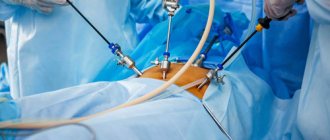Every woman involuntarily thinks about the onset of conception if she experiences characteristic symptoms or experiences a delay in menstruation. The fastest way to determine a possible early pregnancy is to do a rapid test. In case of positive or contradictory results, he may push the woman to go to the gynecologist for an ultrasound. But at what day of delay will an ultrasound show pregnancy? And when should you go for testing? You will find answers to these questions below.
How does fertilization occur?
To find out why a pharmacy pregnancy test often shows results earlier than an ultrasound and when a baby can be seen on a scan, it is important to understand how conception occurs.
Fertilization of the egg usually occurs in the middle of the menstrual cycle, during ovulation. Immediately after this, the fertilized egg begins its journey through the fallopian tubes into the uterus. After 5-6 days, the embryo enters there, and the implantation process occurs. Within 14 days - before the start of the next menstruation - the embryo must be completely embedded in the uterine mucosa and endometrium. At this time, the expectant mother may feel the first visible signs of pregnancy. This is a nagging pain in the lower abdomen and small bloody discharge from the vagina, which quickly passes.
At this moment, the woman’s body begins to actively produce the “pregnancy hormone” - human chorionic gonadotropin (hCG). This substance causes the first signals (nausea, vomiting, increased appetite), and it is this substance that pharmacy tests respond to.
When to suspect pregnancy
There are several signs when you should take a pregnancy test:
- unusual sensations in the chest and pelvis area, breast swelling;
- drowsiness, lethargy;
- change in appetite or lack thereof;
- a previously unusual aversion to certain odors;
- the appearance of skin pigmentation, allergies, rashes;
- changes in the nervous system (irritability);
- dizziness, nausea.
If a woman is healthy and does not suffer from any menstrual irregularities, then determining her “interesting position” is quite simple - any deviation from the schedule, even for 2-3 days, can be a reason for a test.
On what day can an embryo be seen on ultrasound?
Since for a pregnancy test the main indicator of the expectant mother’s position is the hCG level, it shows a positive result quite early. Classic tests do this literally on the 1st-2nd day of the delay (13-14th after conception). There are also special tests for early pregnancy. They can diagnose conception even before the delay, 7-8 days after fertilization.
At 3 weeks of pregnancy, the size of the fertilized egg is only 1 mm; it is a spherical accumulation of rapidly dividing cells that does not yet have organs and systems. It is not advisable to do an ultrasound at this time. Even if a uzologist accidentally discovers this cell formation for some reason, he will not be able to diagnose pregnancy with one hundred percent accuracy. Only by ordering an additional examination after a delay can one determine gestation with high accuracy.
Ultrasound works according to a different scheme - to make a diagnosis, the sensor must see the embryo in the uterus. On what day after conception is this possible? Usually the scan shows the fetus 4-5 weeks after fertilization - on the 7-10th day of delay. Before the delay, ultrasound cannot determine whether a woman is pregnant.
At this time, there is no full-fledged fetus in the uterus yet, so only the fertilized egg in the form of a small black dot is visible on the monitor. It is usually located in the upper part of the uterine cavity. The future baby on ultrasound is a small white formation inside the egg.
Types of ultrasound diagnostics
There are two modern methods:
- Transvaginal ultrasound. It is used after the third week of pregnancy, that is, on the 7th–10th day of delay. The countdown is from the first day of the last menstruation. This technique is rarely used at earlier stages, since for a qualitative study the size of the embryo should be about 0.5-0.7 cm and before it simply will not be visible. It is more often used as a screening.
- Transabdominal ultrasound. This study is carried out with a device whose sensor is placed on the front wall of the abdomen. In this case, the distance to the uterus is quite large. This nuance allows for accurate diagnosis no earlier than the fifth week and later. Otherwise, the results may be erroneous. Both methods are considered safe and cannot in any way harm the woman’s health or affect the development of the embryo.
How to choose an ultrasound to determine pregnancy
The timing at which pregnancy can be diagnosed largely depends on the type of ultrasound. When carrying a baby, two types of scanning can be used - internal (transvaginal) and external (transabdominal).
Transvaginal is usually used in the first trimester, 4-9 weeks. At this time, internal ultrasound is the most informative, since during the examination the sensor is as close as possible to the uterus. A transvaginal examination can see the baby already on the 5-10th day of the delay, starting from the 4th week. The diameter of the fertilized egg at this time is only 2-4 mm.
Transabdominal ultrasound - through the outer wall of the abdomen - is preferably done at a later date. In the first trimester, it will show the embryo in the patient’s uterus only on the 21-22nd day after the delay, from the 6-7th week. The diameter of the fertilized egg with the embryo inside at this stage is 5-7 mm.
When is the test negative?
A negative result does not always mean that conception has not occurred. There are many cases where the test stubbornly could not detect two bands, but after nine months the woman eventually gave birth. Therefore, if all the signs of an interesting condition are on your face, but during the check only one line appears, then you should consult a doctor.
Why can the test show one line when in fact the body is preparing to give birth? This situation may be caused by illness. For example, if a woman has endocrine system dysfunction. The test will be negative if the mother's body is about to reject the embryo, in other words, a miscarriage is about to occur during the initial weeks.
In the first two weeks after the delay from the last menstruation, for some representatives of the fair sex, the level of a special hormone in the urine still remains low.
One band can be determined if there are diseases of the heart or genitourinary system. If a woman suffered from pyelonephritis several weeks ago, then the drug may well show only one strip instead of two, even if the delay is already more than a week.
What factors can affect the ultrasound result?
For a correct ultrasound result at an early stage, it is necessary not only to choose the right research method. It is important to observe several more factors:
- Sufficient time after conception. In order for the ultrasound to reliably see and show the unborn baby on the monitor, it is necessary that the embryo has time to grow at least a little. Otherwise, the sensor may mistake it for a structural feature of the uterus, a small tubercle, inflammation or polyp.
- Absence of inflammatory processes in the patient’s uterus. Inflammation can provoke swelling of the mucous membrane, and then the already tiny embryo will be completely invisible.
- The study should be conducted by a specialist with extensive experience working with pregnant women. It is a qualified sonologist (the one who does the scanning) who will be able to distinguish a full-fledged embryo from a tubercle or inflammation.
- Modern equipment. Early ultrasound simply needs to be done in a good clinic using new equipment. High-resolution monitors will provide a more accurate picture, which means a reliable diagnosis.
When and how can you determine the exact date?
It is much better to use modern methods of determining pregnancy. They allow you to determine the exact date and calculate the expected date of birth.
Test
Today there are quite a few different tests.
They all work through contact with urine. You need to understand that there are manufacturers offering both high-quality and low-grade products.
List of several brands that produce reliable tests:
- Frautest;
- clearblue;
- Evitest;
- Premium Diagnostics;
- Lady Test.
Reference. The test accuracy is 99%. Therefore, in order to know the result for sure, you need to conduct a control study. Using them at home is not difficult. And tests are sold in pharmacies.
Ultrasound
This is the most reliable way to find out about the birth of a new life. It also allows you to:
- find out the gestational age;
- study the features of fetal development;
- identify pathologies.
Thus, an ultrasound should be performed in any case, even after the doctor diagnoses pregnancy.
This type of study is carried out several times throughout the entire period. It must be taken into account that the baby does not like being disturbed by sound. Therefore, there is no need to perform an ultrasound again.
Medical examination
A doctor can confirm the fact of pregnancy using several parameters:
- The skin and mammary glands are examined. The latter should be slightly swollen.
- The outer labia become slightly bluish.
- Changes in the cervix. She may change her position slightly.
- Change in color of the mucous membrane from pink to bluish or purple.
- Mucus from the cervical canal becomes more viscous and transparent.
- The uterus increases slightly in size.
If you have any suspicions, you must obtain an appointment for examination.
To do this, you need to donate TAM, UAC and blood for hCG. Thus, today you can detect pregnancy in several ways. You can make sure that a girl is expecting a baby through tests and an ultrasound. Based on these data, we can conclude that everything is going well and calculate the expected date of birth. The latter is necessary for the timely completion of all documents and preparation for the trip to the maternity hospital.
In what cases is an early ultrasound necessary?
If the test to determine pregnancy shows a positive result, then you first need to visit a gynecologist. And after an external examination, he will send you for an ultrasound if he finds clear signs of possible conception. But there are situations in which ultrasound examination is mandatory:
- If there is a delay, but the second line on the pregnancy test is very weak. In this case, the doctor will usually send the woman for a blood test to measure hCG levels before the scan. In case of pregnancy, this will help with further monitoring of the patient.
- If your period does not come on time and your lower abdomen hurts at the same time.
- If the delay is already long (day 10-14) and spotting (even minor) appears.
- If the test confidently shows two lines, but the obstetrician-gynecologist did not find visible signs of pregnancy.
How to understand that you are pregnant or not?
At the initial stage, no changes occur.
A girl may not be aware of her condition for more than a month. And if there are problems with the cycle, two months may pass. However, there are several ways to know that a baby is coming soon. It is worth considering them in more detail.
Traditional methods
There are many folk methods with which you can find out about conception. However, you need to understand that this is not scientifically substantiated, so the result does not provide a 100% guarantee of results:
- You need to collect morning urine and boil it in a metal container. If sediment or white flakes appear, then the girl is pregnant.
- Mix urine with wine. Its cloudiness means that sexual intercourse did not lead to the birth of a new life inside the female body.
- Changing taste preferences. This is not always evidence of pregnancy. However, a sharp change in tastes may indicate that a woman is expecting a child.
Reference. After fertilization, the body begins to undergo rapid restructuring. Initially, the girl may not feel this. The above methods cannot be considered reliable, but their results often turned out to be correct.
Feels like
Here are some ways to detect pregnancy without a test:
- Measuring basal body temperature. This is done lying down in the morning, when you are still in bed. There is no need to make sudden movements. Its sharp increase indicates that new life has appeared inside the body.
- You can use baking soda. During pregnancy, the color of your urine will change. Just add a small spoon of soda there.
- A piece of paper with iodine, which is placed in the morning urine, will also allow you to independently determine the result. If the iodine turns out to be blue, then you are not pregnant. If the result is positive, it will turn purple.
- Increased sense of smell.
- Breast enlargement and pain. However, girls experience such sensations even before the onset of menstruation.
- Changing your diet and increasing your appetite.
- Frequent urge to go to the toilet, but they appear when the fetus is already large and puts pressure on the bladder.
- Increase or decrease in sexual desire.
To get an accurate result, you need to collect only morning urine. Before the procedure you need to wash. The container must be sterilely clean.
Ultrasound and missed period
When a woman is faced with a delay in her menstrual cycle, then this will be either a joy for her or a reason for worry. It all depends on whether she wants a child.
If everything is clear with the first contingent, then the second immediately run for a pregnancy test.
In any case, whether the test is positive or not, you should definitely contact a gynecologist who will conduct an examination and most likely prescribe an ultrasound of the uterus.
Other reasons for missed periods
If pregnancy is ruled out for a woman, then it is urgent to find out the reason why the delay occurred. Ultrasound for delayed menstruation is very widely used due to its wide range of detectable pathologies.
The most common cause of delayed menstrual cycle among diseases is polycystic ovary syndrome. This disease is a hormonal disorder in which many cysts form in the ovaries, seriously disrupting the functioning of the female reproductive system.
But in addition to the ovaries, the pancreas, adrenal glands, pituitary gland and hypothalamus can also be affected. Although polycystic disease is characterized by increased production of male hormones, the exact causes of its occurrence have not been established.
Two main theories suggest either dysfunction of the pituitary gland and hypothalamus, or the body's resistance to insulin or other causes related to the functioning of the pancreas.
In this case, an ultrasound scan with a delay in menstruation will be characterized by a number of clearly visible signs. Since both ovaries are most often affected, an ultrasound will show a significant increase in the volume of the ovaries (more than 7 cm3) .
The diameter of the cysts varies from 2 to 12 mm , and their number in each ovary is more than 10 pieces . Such formations will be located along the edge, but not in the center of the ovary.
Statistics also show that women without menstrual irregularities and having a good reproductive picture may well have the above-described characteristics of the ovaries.
This phenomenon occurs in approximately 20% of cases. An important problem of polycystic ovary syndrome is infertility. This does not mean at all that they are sick, it’s just that at the moment this pathology is rather poorly studied.
One of the most dangerous causes of a delayed menstrual cycle is an ectopic pregnancy. In this case, the fertilized egg is implanted not in the uterus, but outside it. This could be the abdominal cavity, fallopian tubes, ovary, etc. With this course of pregnancy, the growth and development of the fetus is impossible, and the patient’s condition may suddenly worsen.
One of the first signs of the disease is severe pain and bleeding from the vagina. If the egg is attached to the fallopian tube, it may rupture, which will lead to a decrease in the woman’s reproductive function and a high risk of her life.
An important element of diagnosis in this case is urgent diagnosis through a gynecological examination and ultrasound examination.
Both vaginal and abdominal methods are used as methods.
An abdominal sensor allows you to determine the presence of an ectopic pregnancy in the late stages, around the tenth week from the onset of the disease, while a transvaginal sensor can detect it already in the fifth.
Since the most common place for attachment of an egg is the fallopian tube, an ultrasound of the female genital organs allows you to do it as early as possible and preserve reproductive function in the best possible condition.
Most often, an ultrasound can detect an ectopic pregnancy at 6-10 weeks of the disease, since it is at this moment that the fetus begins to actively grow and damage the tube.
Treatment of this pathology is carried out surgically, and in the future the woman will be strongly recommended to undergo regular ultrasound examinations in order to avoid complications and recurrent ectopic pregnancy.
Another important disease that leads to menstrual irregularities is uterine fibroids. A benign neoplasm that may lead to the need for complete removal of the uterus, although in the early stages it is quite easy to treat. Diagnosis of such a disease requires an ultrasound scan on a predetermined day of the menstrual cycle.
In addition to benign ones, there can also be malignant neoplasms that disrupt the menstrual cycle causing a delay in menstruation. All these diseases are visualized using ultrasound, and their malignancy or benignity can be determined using the same method. But an accurate diagnosis can be made only by final histological analysis.
In addition to serious morphological disorders, the cause of delayed menstruation can be depression and frequent stress or abortion, recent childbirth.
Danger
As such, there is no danger in delaying the menstrual cycle, but there is always a reason that served as a trigger for the failure.
Therefore, any woman should be examined and consulted by a doctor who will conduct a conversation with the patient, in which he will explain all the nuances of the upcoming treatment and diagnosis.
Some women may believe that ultrasound is extremely harmful to them and the fetus and may refuse. The gynecologist must explain everything and establish contact between him and the patient.
In the modern diagnosis of gynecological diseases, ultrasound in the event of a delay in menstruation is an important element of diagnosis, which allows not only to determine the presence or absence of pregnancy, but also quite dangerous diseases that, if severe, can lead to infertility or death. In this regard, all patients should be extremely attentive to their women's health and, at the slightest symptoms indicating a disease, they should contact a gynecologist.
SHARE WITH YOUR FRIENDS AND VOTE: ( 5 5.00 out of 5) Loading…
Source: https://uzipro.ru/uzi-malogo-taza/uzi-i-zaderzhka-mesyachnych.html
Danger
As such, there is no danger in delaying the menstrual cycle, but there is always a reason that served as a trigger for the failure. Therefore, any woman should be examined and consulted by a doctor who will have a conversation with the patient, in which he will explain all the nuances of the upcoming treatment and diagnosis. Some women may believe that ultrasound is extremely harmful to them and the fetus and may refuse. The gynecologist must explain everything and establish contact between him and the patient.
In the modern diagnosis of gynecological diseases, ultrasound in the event of a delay in menstruation is an important element of diagnosis, which allows not only to determine the presence or absence of pregnancy, but also quite dangerous diseases that, if severe, can lead to infertility or death. In this regard, all patients should be extremely attentive to their women's health and, at the slightest symptoms indicating a disease, they should contact a gynecologist.
Why ultrasound
Both in the case of pregnancy and for reasons causing delays or disruptions in the menstrual cycle, ultrasound diagnostics are used. Ultrasound diagnostics has been in medical practice for quite some time and has become widespread. The ultrasonic waves emitted by the device are absolutely not harmful to the body, since they do not carry harmful particles, such as x-rays. The speed of the examination is quite high - 15-30 minutes, and the results are obtained almost immediately.
Although this examination method is quite good, in gynecology we must not forget the importance of a preliminary interview, collecting information about life, previous diseases and diagnosis using a gynecological examination. In addition, the results of the ultrasound examination are assessed by your gynecologist.
The optimal time to visit the doctor
So, the test showed a positive result. What's next? Now you need to decide on the timing of your visit to the gynecologist. It's better not to delay this. In addition, getting to the clinic at your place of residence is not always easy and does not happen right away. The optimal time for a visit is at 4-6 weeks, but no later than 12 weeks. You shouldn’t believe those who say that you can register almost in the middle of pregnancy. It is better to go to the doctor immediately after receiving a positive result.
Such early treatment is necessary to ensure full monitoring of the progress of pregnancy. The doctor will also prescribe a series of tests and examinations to find out what diseases the mother has. Using an ultrasound, it will be possible to determine the location of the fetus. The study will show where the embryo has implanted - inside or outside the uterus.
Also, early contact is necessary for the gynecologist to register the woman for pregnancy. This will help protect the future baby. For example, all people are required to undergo fluorography. However, X-ray irradiation is very harmful to the baby and a pregnant woman should absolutely not undergo it. Timely registration will allow you to avoid going through this procedure, which is dangerous for the nascent life.
Preparation for the procedure on critical days
It is important to follow your doctor’s recommendations and properly prepare for an ultrasound if your period has not yet ended.
Basic Rules:
- To conduct an ultrasound of the uterus, a vaginal sensor is required, so take a shower and carry out hygiene measures before the examination;
- It is better to take a disposable absorbent diaper to your appointment;
- the examination is carried out on an empty bladder;
- Douching is not allowed;
- For patients suffering from increased gas formation, 2 days before the appointment, exclude some foods from the diet (baked goods, legumes, sweet fruits), and do a cleansing enema the night before.
Thus, it is advisable to do an ultrasound during menstruation on days 5–7 of the menstrual cycle, so that the diagnosis is as informative as possible.
Share the information with your friends so that they can know whether it is possible to conduct an examination during menstruation, and when the procedure is undesirable. Share your thoughts in the comments. Stay healthy.











